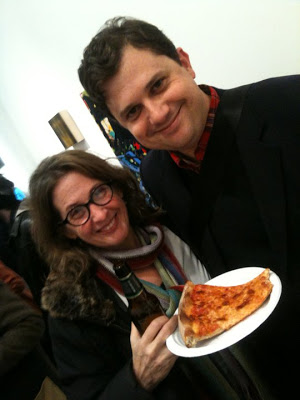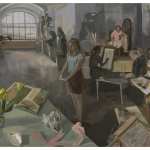James Panero and me discussing social networking media face-to-face over pizza and beer at an exhibition at STOREFRONT in Bushwick. Photo courtesy Jason Andrew.
In �My Jerry Saltz Problem,� a spiritedly discursive philippic in the New Criterion about the changing nature of art criticism, James Panero articulates how disgruntled print journalists and traditional art critics feel about new media such as blogs, Twitter, and Facebook. Panero pines for the longer deadlines, the romantic hours spent at his desk crafting insightful long-form essays, the touch and feel of ink on coated paper, the discrete objects known as magazines. Then he suggests that Jerry Saltz, one of the few art critics to fully embrace social networking tools, has compromised the art critic�s role by becoming part of the story. �On Facebook and now elsewhere online,� Panero writes, �Saltz regularly mixes portentous metaphysical questions with internet messianism, unctuous flattery of his followers, treacly self-doubt, and gaseous emissions of political cant. The ultimate topic of discussion is not art or even his devoted followers, but Jerry Saltz himself.� As both a social media proselytizer and an enthusiastic contributor to traditional print publications, I think Panero is exaggerating the downside and missing the upside of the new media�s effect on art discourse.
When I started blogging at Two Coats of Paint, blogs were still generally considered the domain of exhibitionist teenagers and oversharing adults. This reputation was somewhat deserved, but I loved the immediacy of the process, the ability to link easily to related online content, the conversations that developed with other artists, and the small but generous art-blogging community. Then Facebook, Twitter, and other social media tools emerged and expanded the internet�s potential as an engine of dialogue and mobilization well beyond the whims of narcissistic shut-ins. At one point, a writer friend who, like Panero, valued print publications more highly than online publishing, suggested I submit an article for publication in a print magazine. I saw it as a new challenge, and perhaps as a good way to promote the blog. When the article was accepted, my friend was pleased and saw it as a validation of my online work.
Of course, I was used to the immediacy of blogging. Several rounds of editing, contract approval, gathering legal images, and the long wait until the article was ultimately published were a little exasperating. If the article was timely when I wrote it, the drawn-out process threatened to render my ideas old news by the time anyone else got to read them. To make matters worse, print publications often withhold online content in order to encourage readers to buy the magazine, so initially there was no way to link to the article from the blog and get a conversation started. Even though I was often paid for print articles, I preferred the public profile and immediate back-and-forth that blogging provided. Yet publication in print undeniably gave me more respectability in the art criticism community, which in turn helped increase the readership of my blog. So in my experience, blogging and print are evolving as complementary rather than truly competitive modes of publication � or at least that is the most constructive way to think about and shape the relationship.
From that point of view, perhaps Panero and others who scold Saltz for degrading his print brand with an uneven and impetuous online presence should be less wary of social media�s encroachment on old-school dialogue and more supportive of the risks Saltz is taking in venturing into new territory. Traditional journalists and art critics tend to dismiss Saltz�s move to Facebook (and more recently, Twitter and blogging) as an expression of self-indulgent megalomania. But that assumes an improbable degree of calculation on his part. It seems to me that Saltz just took a shot at something new, intrigued by the prospect of quick and unmediated feedback. On account of the name recognition he had established as a print journalist, he had a huge Facebook following within weeks � he and I have been Facebook friends since he joined in 2009 � before he had any clear idea of how social networking might affect his status and perspective as a critic. Notwithstanding Panero�s fear and loathing, Saltz is a long way from becoming the Hunter S. Thompson of art criticism. His stumbles and excesses � highly visible and heavily scrutinized due to his pre-internet exposure � are simply part of the process of acclimating to a new environment.
Panero suggests that involvement with social media might compromise a critic�s independence. But professional conflict of interest on account of social relationships is nothing new. What�s new is that thanks to Facebook and Twitter awkward relationships between critics and those who want something from them are no longer secret. On balance, that seems a good thing. In any case, there is nothing intrinsic to a writer�s online activity that imperils his or her credibility as a �serious� art critic. It remains eminently possible, if not likely, that Saltz�s print publications and online presence will cross-fertilize and establish a healthy and sustainable equilibrium.
Although critics tend to label Saltz�s Facebook friends sycophantic loyalists, there�s more synergy there than meets the eye: they have used Saltz�s Facebook wall to build a real community. It�s true that to an extent the internet has �dematerialized� our social relationships, but virtual relationships do have genuine substance. For extremely sociable, outgoing people (which hugely successful artists and writers are more likely to be), the dearth of more tactile contact may be lamentable. For less extroverted types (including many artists of less conspicuous achievement), though, it�s something of a relief that lowers the threshold for productive interaction and networking. Relationships formed online still eventually lead to the real-life interaction that Panero applauds � studio visits, art exhibitions, and more. On that score, Panero�s viewpoint and my own converge: to have an authentic art experience, there�s no substitute for seeing art “in the flesh.”
Related posts:
In the NY Times, Steven Burn writes: Beyond the Critic as Cultural Arbiter
Joanne McNeil’s brief history of blogging at Tomorrow Museum.
var a2a_config = a2a_config || {};
a2a_config.linkname = “Two Coats of Paint”;
a2a_config.linkurl = “https://www.twocoatsofpaint.com”;
a2a_config.prioritize = [“delicious”, “email”, “linkedin”, “twitter”, “tumblr”, “stumbleupon”, “facebook”, “blogger_post”, “google_gmail”, “google_buzz”, “digg”, “aim”];















Interesting essay – I have been following the fracas (er, discussion) and think that some of it is due to the "old style" critics feeling threatened by "us low life types, (i.e.) bloggers). We represent a loss of earnings, a lessening of the respect that they felt they had and are a symbol of a new world in media, the good, the bad and the really really ugly. Outside of the NY Times, some other big time print journals and newspapers and your own blog, there's a real lack of decent arts criticism in the old fashioned print media. As one of the new-fanggled bloggers who write about art, I say – give us a chance because you can't, no matter how you want to, turn back to the way things used to be. If the new media and Saltz can reengage more people with art, maybe that's a good thing. Art has become very elite and the old style critics were happy to keep it that way but if art is to have any audience at all, it needs new voices, both as creators and critics.
James is not saying that Saltz's megalomania expressed itself as a Facebook presence, but the converse. "An over-active online presence often brings out a writer�s inner beast. For Saltz … this has meant a rising megalomania, amplified by a feedback loop of constant faceless online reinforcement. … Two years of online use has instead [of creating an 'art world flatland'] turned him from a reliable writer into the Aleister Crowley of art criticism, where each comment thread portends great visions." Saltz's forays into where no art critic has gone before have rendered him clownish. I too remember the days when he had some utility as a writer. Most of that usefulness has passed to his wife, or maybe she remained in place as he sank under her.
Too, the community of sycophants in Saltz's digital entourage, however "real," nevertheless benefits Saltz far more than it will ever benefit any member, just as James says. It can't be otherwise. When Saltz assessed the "criticism" taking place in the various comment threads associated with his online presence as "practiced… on a fairly high level," it was the biggest act of self-congratulatory faux-radicalism since the College Art Association gave the Frank Jewett Mather award to the Guerilla Girls. Who as of this morning are following me on Twitter, where they are making the rounds in support of their latest ploy for attention. The irony is how much seems to change, and how little really does.
A brief thank you for a balanced, sensible response to this issue.
and Happy New Year!
A great response. I thought Panero seemed like an old man complaining about not having boiled carrots for dinner.
Interesting discussion and a conundrum that surrounds online 'journalism', whether for blogs or paid publications.
My sister writes for a living, for one of the last city newspapers, (although not in NY) and these are published online. The original content of her book reviews are slashed and edited to be almost unrecognizable.
The paper's policy, of course, is to draw in a younger demo with a short attention span. In brevity, we lose the journalist's or writer's craft and in my opinion, that's a bigger problem.
But that said, opening up arts criticism to the larger public is a good thing. I can recall the days when it was almost impossible to slog through some arts magazines; the focus on theory induced severe eye glazing over.
Sharon, I have been meaning to thank you for your thoughtful response. Your perspective as a writer starting online and moving over to print will certainly be the norm in the near future–assuming "print" even exists (it will probably transition into luxury downloads for the iPad). For me it is not ink on a page that makes the difference, but the editorial mechanics of print-style production–from its system of editors and fact checkers to its self-imposed brand standards, which serve to guide critical behavior, as well as its ability to provide income to the writer. On the upside, the great benefit of online writing and social networking is its low barriers to entry. I also enjoy using them. On the downside, these online systems alone offer little of the qualities that has made print writing great. Therein lies my concern.
The loss of income is an extremely important issue, but perhaps 2011 will be the year that online publishing begins to generate more revenue for writers and bloggers. Certainly the growth of niche for-profit aggregation sites indicates that advertisers are willing to pay for content generated by the online community. Let's hope writers are included in their payday.
Saltz's criticism remains sullied by the appearance of payola. He has championed sexist artists like Koons, Prince and good old baby boomer stand-by's like Brice Mardens and Richard Serra. While bemoaning the lack of female representation in the art world he supports Koons poorly composed collages of women positioned as fun objects for boys, along with feel happy toys like balloons and blow ups. Never once does Saltz address Koons sterilization of painting or Marden's sliding of painting into the somnambulance of lava lamps. Richard Serra has been making the same drawing for 30 years and no one says anything, except the happy collectors, to whom Saltz seems to be always trying to soothe. It's this collusion that renders his 'reviews' (he does not do criticism) as suspect. At one point on his NYMag site, you could not write in the name Jeff Koons, that should tell u something.